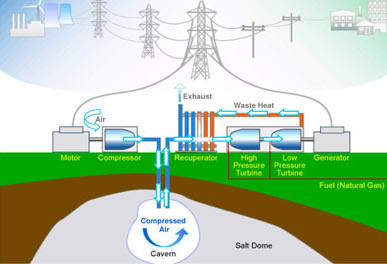A coalition of local utilities is planning a unique and innovative system to store excess wind energy that until now could only be transferred in real time back into the electrical grid or wasted.
The group is building a system that will steer surplus electricity generated by a nearby wind farm to a big air compressor. Connected to a deep well, the compressor pumps air into layers of sandstone. Some 3,000 feet down and sealed from above by dense shale, the porous sandstone acts like a giant balloon. Later, when demand for power rises, this flow is reversed. As the chamber empties, a whoosh of air flows back up the pipe into a natural-gas-fired turbine, boosting its efficiency by upwards of 60%.
The System also lets the utility sell the stored energy when demand is peaking and prices are highest, says Kent Holst, the park's development director. Backed by funding from the Energy Dept., more than 100 municipal utilities in Iowa, Minnesota, and the Dakotas are ponying up a total of $200 million to build the 268-megawatt system. Begun in 2003, the project is on track to go online in 2011.
The compressed air energy storage (CAES) project is the lowest-cost way to store very large volumes of power, according to the Energy Dept.'s Sandia National Labs. While American Electric Power Co. (AEP ) and Siemens Wind Power (SI ) are testing truck-sized batteries with capacities of amegawatt or more, big batteries rely on costly, exotic chemicals. CAES, in contrast, combines less pricey industrial machinery with the earth's free storage capacity. And while battery life is measured in hours, the geology below the Iowa project can store about 20 weeks' worth of air supply.
Wind is the nation's fastest-growing form of renewable energy. In the past five years output from wind farms has grown tenfold, to more than 12,000 megawatts, or about 1% of total U.S. supply. Its fans predict that someday wind could supply 10% or more of the nation's electricity. That's already the case in Spain and Denmark.

